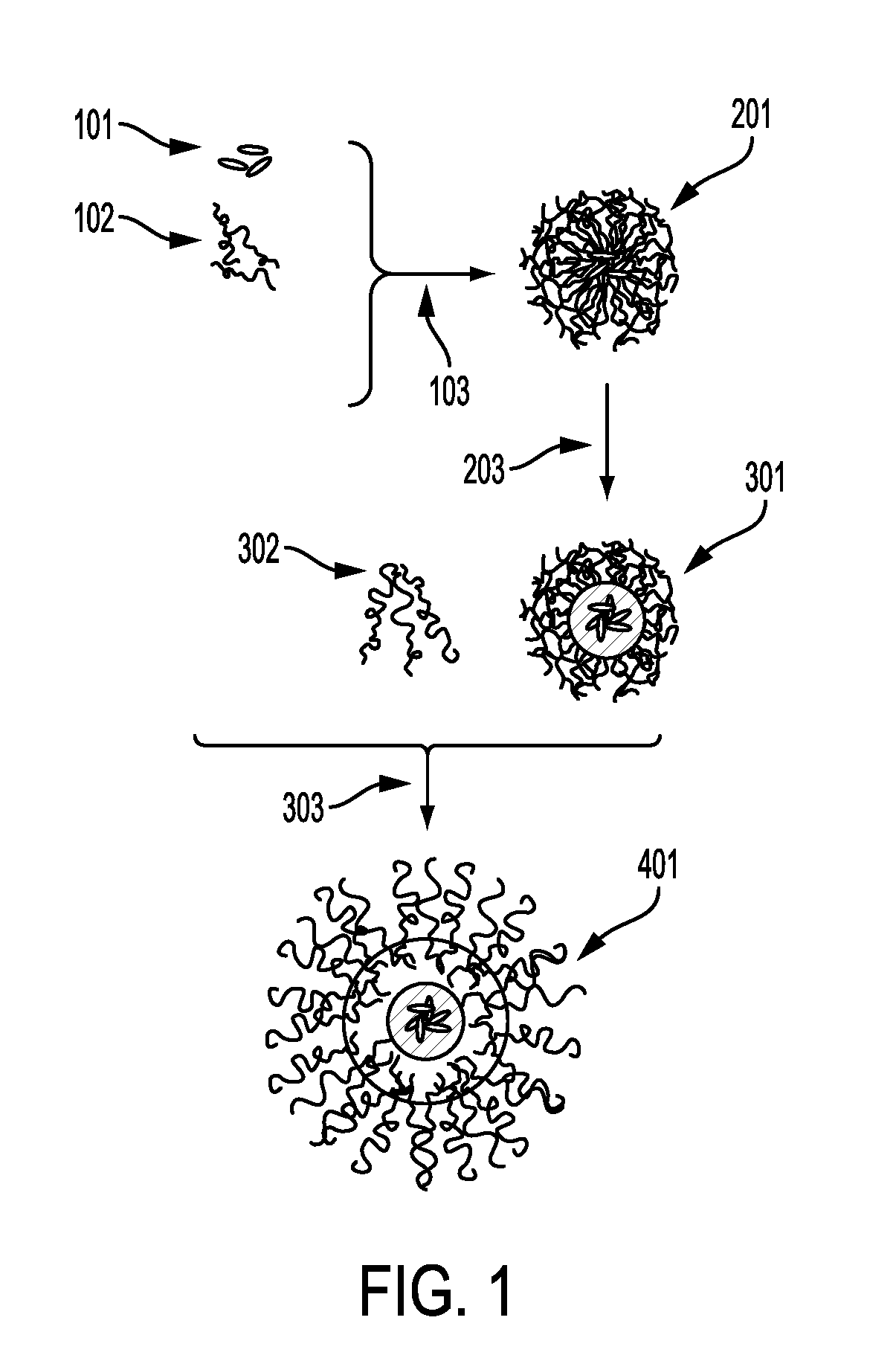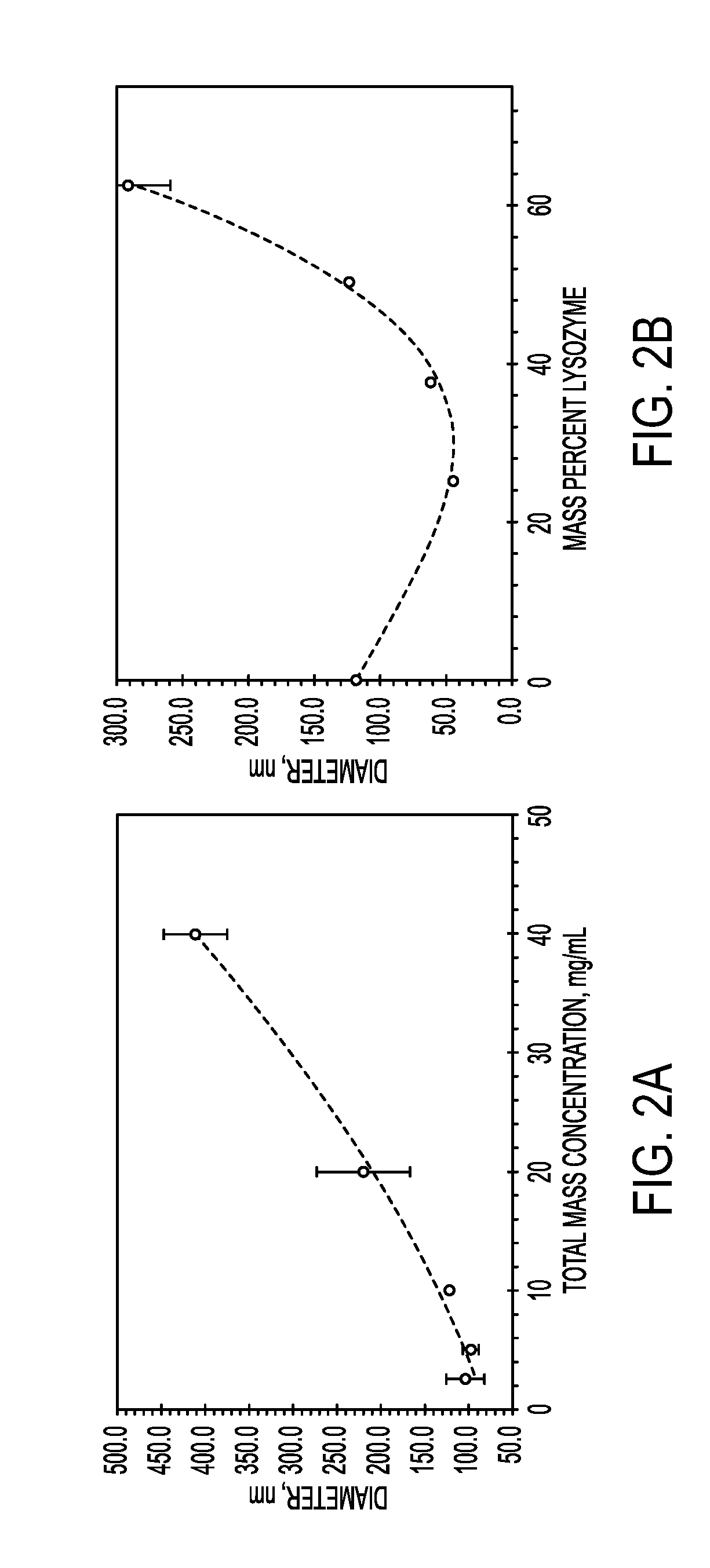Process for encapsulating soluble biologics, therapeutics, and imaging agents
a technology of soluble biologics and hydrophilic cores, applied in the field of making nanoparticles having a hydrophilic core, can solve problems such as less developed areas
- Summary
- Abstract
- Description
- Claims
- Application Information
AI Technical Summary
Benefits of technology
Problems solved by technology
Method used
Image
Examples
example 1
Assembly and Morphology
[0099]To produce particles containing hydrophilic compounds, poly(n-butyl acrylate)7.5kDa-b-poly(acrylic acid)5.5kDa (PBA-b-PAA) and the biologic were first dissolved in a polar organic solvent such as DMSO or methanol. In an FNP process, this stream was rapidly mixed with a less polar nonprocess solvent such as chloroform (CHCl3) or acetone in a CIJ mixer. The non-solvent caused the biologic to precipitate. This precipitation was halted by the self-assembly of the hydrophilic PAA block of the PAA-b-PBA on the growing particle surface. The final particles were sterically stabilized in the non-solvent by the hydrophobic PBA block. The resultant nanoparticle had a core-shell structure.
[0100]This process has been applied to an assortment of model hydrophilic agents with varying molecular weights, including lysozyme as a model protein (14.3 kDa), the cyclic peptide antibiotic vancomycin (1.45 kDa), a model 7-amino acid long peptide (glycine-arginine-leucine-glycin...
example 2
cle Loading and Size Control
[0101]The sizes of particles produced with FNP may be controlled through the time scales for precipitation of the core material, as well as through the time scale for polymer self-assembly. These time scales are modulated through material concentrations as well as through the choice of nonprocess solvent.
[0102]Increasing the percentage of core material necessitated the formation of larger particles. For both lysozyme and vancomycin, the particle size initially decreased as biologic was added compared to the micelle size of the block copolymer. This may be because the addition of core material allows the PAA to more tightly pack due to charge shielding effects. Very high loadings of both lysozyme and vancomycin were obtained. Loading of lysozyme as high as 75 wt % was obtained without the formation of large precipitates, however, the particles were too large to analyze using dynamic light scattering (DLS). Vancomycin loadings up to 90 wt % resulted in stab...
example 3
tion of Nanoparticles for Further Processing
[0104]In order to stabilize the nanoparticles in aqueous environments and reduce the loss of encapsulated material during processing steps, methods of crosslinking the PAA shell in order to form a gel were investigated. Ionic crosslinking was focused on because it reduces the risk of covalently modifying the encapsulated agent. The anionic PAA side groups may be crosslinked either with multivalent metal cations or polyamines (S. Bontha, A. V. Kabanov, T. K. Bronich, Polymer micelles with cross-linked ionic cores for delivery of anticancer drugs, J. Controlled Release. 114 (2006) 163-174; T. K. Bronich, A. V. Kabanov, V. A. Kabanov, K. Yu, A. Eisenberg, Soluble Complexes from Poly(ethylene oxide)-block-polymethacrylate Anions and N-Alkylpyridinium Cations, Macromolecules. 30 (1997) 3519-3525; T. K. Bronich, P. A. Keifer, L. S. Shlyakhtenko, A. V. Kabanov, Polymer Micelle with Cross-Linked Ionic Core, J. Am. Chem. Soc. 127 (2005) 8236-8237; ...
PUM
| Property | Measurement | Unit |
|---|---|---|
| size | aaaaa | aaaaa |
| sizes | aaaaa | aaaaa |
| sizes | aaaaa | aaaaa |
Abstract
Description
Claims
Application Information
 Login to View More
Login to View More - R&D
- Intellectual Property
- Life Sciences
- Materials
- Tech Scout
- Unparalleled Data Quality
- Higher Quality Content
- 60% Fewer Hallucinations
Browse by: Latest US Patents, China's latest patents, Technical Efficacy Thesaurus, Application Domain, Technology Topic, Popular Technical Reports.
© 2025 PatSnap. All rights reserved.Legal|Privacy policy|Modern Slavery Act Transparency Statement|Sitemap|About US| Contact US: help@patsnap.com



